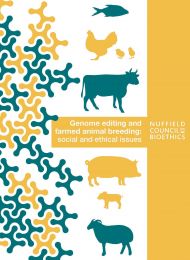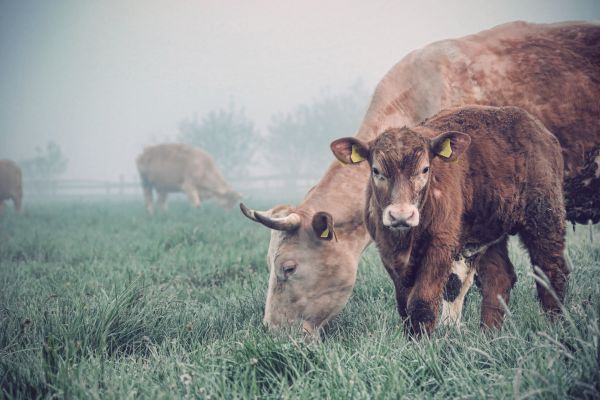Genome editing and farmed animal breeding: social and ethical issues
Report
Published 01/12/2021

Challenges facing our food and farming systems
See chapter 2 of the full report
The global food and farming system faces complex challenges which we have grouped under five main headings. The implementation of new biotechnologies, such as genome editing, in the global food and farming system may represent a means to address these challenges but also, potentially, to worsen them.
1. Animal health and welfare challenges
Animal welfare is a wider concept than animal health. It includes not just the physiological condition of the animal but the full range of experiences that constitute a good life. Various aspects of husbandry will affect animals’ welfare, such as their living conditions, how much space and exercise they have, what they are fed and how often, access to veterinary care, their ability to form social bonds with others of the same species, and the physical and psychological effects of common farming interventions such as de-horning, tail docking, and castration.
Breeding systems that have focused on developing productivity traits in the past (e.g. increased carcass size and litter size) have had many negative effects on animal health and welfare. For example, genetic selection for high egg production in laying hens has been shown to cause osteoporosis and put hens at increased risk of bone fractures.
As information and understanding of the effects of different farming and breeding systems have increased, there been some improvements in some aspects of the conditions in which animals are kept, and some progress towards environmental objectives in breeding programmes. However, standards vary across the world, and many aspects of animal health and welfare continue to present challenges to the food and farming system.
2. Human health challenges
There are several risks to human health associated with farming and the consumption of animal products, including:
- Increased risk of non-infectious diseases that can be linked to diet, such as certain cancers, heart disease and type-2 diabetes.
- Infectious diseases that are naturally transmitted between animals and humans. The scale of their effect was demonstrated by the COVID-19 pandemic, caused by the SARS-CoV-2 coronavirus which first emerged in animals before transferring to humans. Livestock may be a significant transmission link between wild animals and humans as well as an incubator of new disease variants.
- Antimicrobial resistance (AMR) results from changes in bacteria, fungi, viruses, and parasites following exposure to antimicrobial drugs. Indiscriminate use of veterinary antibiotics has been linked to increasing levels of AMR. AMR represents a major threat to both human and animal health, mainly as a result of reducing the range and effectiveness of medicines available to treat infections.
3. Challenges of demand and supply
Demand for animal products is increasing, not only because we have more people to feed as our global population rises, but also because worldwide, people are eating more meat. The supply is precarious though, particularly in areas where people are vulnerable to disruption e.g. as a result of political, economic, or climate instability. Two of the most important factors affecting supply of livestock are climate change (e.g. low rainfall and rising temperatures) and outbreaks of animal disease.
International trade is essential for most countries to secure a reliable supply of a variety of foods. The UK, for example, is not self-sufficient. It is a net importer of beef, poultry, pork, and lamb.
Reliance on international trade exposes a national food system to risks: the fluctuation in global markets can affect food supplies and price stability. The food supply, both in terms of the livelihoods of farmers and the choice of food available to consumers, is highly influenced by major food retailers. Livestock and fish farming are major components of the global food supply, but are increasingly being challenged because of their contribution to environmental damage (see below).
4. Social, cultural and political challenges
What people eat depends on a variety of factors including social, cultural, religious, moral, political, environmental, and economic factors.
There are differences in consumer trends of meat consumption between high- and low-income countries. In some high-income countries the amount of meat consumption is stable or falling, though vegetarianism is rare (less than 10% of the population) and veganism rarer still (though increasing). Worldwide, however, and especially in low-income countries, meat consumption is rising, associated with increased income, urbanisation, and population growth.
If more countries start to follow this trend, thechallenge will be to avoid the negative impacts (e.g. for public health, communities, and the welfare of farmed animals) that accompanied historical rises in meat consumption in industrialising countries.
5. Environmental and ecological challenge
This set of challenges includes:
- Greenhouse gas emissions – methane emissions from cattle, nitrous oxide from animal waste, and carbon dioxide from the production of animal feed are some of the largest direct contributors to greenhouse gas emissions in the livestock sector. Emissions are expected to rise over the coming decades due to an increase in demand for meat and milk unless significant steps are taken to reduce them.
- Waste and pollution – the management of livestock waste presents a disease and pollution risk. Its management, processing, recycling and disposal are therefore important challenges for farming systems. The negative effects of waste are likely to be worst in low-income economies where environmental regulations and large-scale water treatment may be limited.
- Water scarcity – on average, agriculture uses 70 per cent of the world’s freshwater supplies, with about 20 per cent of that used for livestock. A small amount of this is drinking water for animals, while most is consumed indirectly in feed production, as well as in processing, washing, cooling and waste management. In some regions such as Asia and North Africa, the irrigation of crops used to feed animals puts significant pressure on the water supply.
- Deforestation – an estimated 73 per cent of forest loss in tropical and subtropical regions is due to the conversion of forest to agricultural land, much of which is used to support livestock. A key driver of deforestation in South America is for the production of soybeans for animal feed consumed mainly by pigs and poultry. Deforestation is linked to a rise in zoonotic diseases (diseases that transmit from animals to humans).
- Biodiversity – land used for grazing and feed crops in livestock production is perhaps the largest single factor accounting for biodiversity loss. Overgrazing has had a mainly negative effect on wildlife – e.g. through trampling and removal of vegetation, damage to root systems, and displacement of wild animals.
CONCLUSIONS IN BRIEF
The way in which the global food and farming system is organised and run makes it morally indefensible and unsustainable in its present form.
The ways in which we produce and consume food will have to adapt in order to provide a secure and sustainable supply of nutritious food for our growing global population.

Share